Expert’s Rating
Pros
- Well-rounded features for gamers and content creators
- High build quality, premium feel
- Next-gen performance: VRMs, DDR5, PCIe Gen 5, USB4
Cons
- Overall higher AM5 platform costs make this a premium experience
- 10GbE networking would be welcome at this level
Our Verdict
The Asus ROG Crosshair X670E Hero is packed with great next-gen features such as DDR5 and PCIe Gen 5, comes with plenty of USB ports and M.2 slots, and has a slick premium design. It has pretty much everything a serious gamer or content creator would need, plus some. It lacks high-end 10GbE networking, but in terms of features and performance per dollar, it doesn’t get much better.
Price When Reviewed
$699.99
Best Prices Today: Asus ROG Crosshair X670E Hero

$709.99
AMD’s Ryzen 7000 CPU lineup is here, and hot on its trail are the new X670E motherboards. What’s a “Hero” without a great sidekick, after all!
Much like a superhero, the Asus Crosshair X670E Hero is ready to deliver the goods. Its arsenal includes DDR5, PCIe Gen 5, and enough chops to power the fastest Ryzen CPUs.
Being an enthusiast favorite in previous generations, the Hero lineup aims to provide a similarly premium experience with this gen. In addition to its robust performance and ample features, it also offers an eye-catching gamer-approved design. It has enough features to entice content creators to its corner, too. (Fast USB4 being one mouthwatering addition.)
The X670E Hero wants to be worthy of your superhero bucks. We’ll discuss the specs, features, design, and performance. We’ll see if this board alongside the Ryzen 7000 is the perfect duo to beat your supervillain foes.
Asus ROG Crosshair X670E Hero: The specs

Thiago Trevisan
The Asus ROG Crosshair X670E Hero has an MSRP of $699, placing it squarely in the realm of high-end enthusiast motherboards. It’s targeted towards gamers, but has the goods to please workstation users, too. (Many people are using mainstream platforms since HEDT has priced out reasonable budgets.)
We’ll look at the specs list, and more importantly, cover which features you should keep a keen eye on. Of course, you’ll need a new Ryzen 7000 CPU—there’s no backwards compatibility with Ryzen 5000 due to the new chipset.
If you’re considering X670E, you’ll have some benefits over the cheaper mid-level B650 options. You’ll get twice the theoretical USB and SATA ports with X670E. It will also give you more PCIe lanes, with PCIe Gen 5 for the GPU along with your NVMe drives. (B650 also has an “B650 extreme” variant, plus a standard B650—adding some complexity to the product stack. Here’s our recent review of the Gigabyte B650 Aorus Master.)
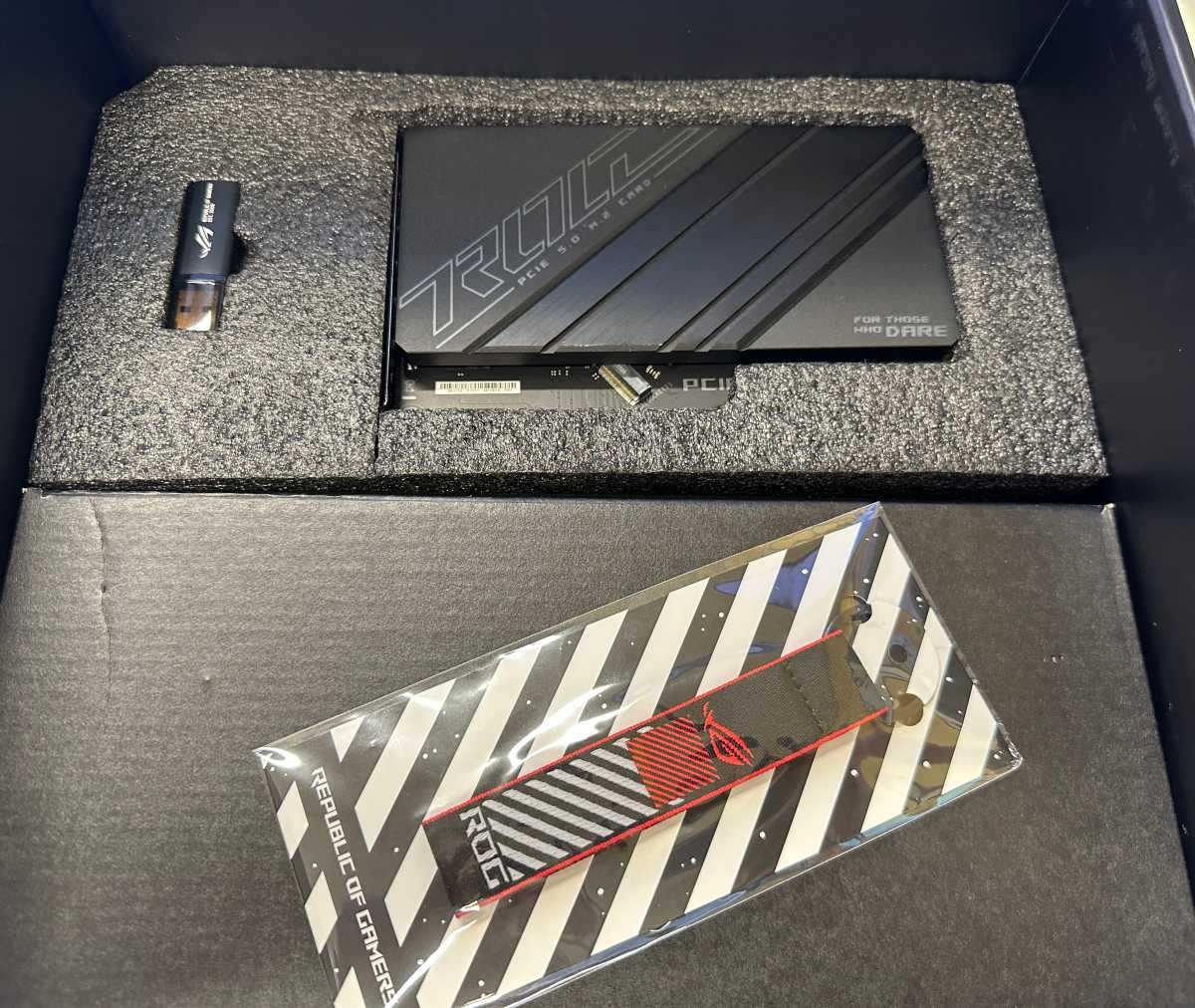
Some of the neat included extras with the Asus Crosshair X670E Hero.
Thiago Trevisan
To further cement this board’s premium position, the unboxing experience is amplified over mere mortal-level motherboards. You’ll get some nice ROG goodies in the box such as a ROG M.2 PCIe card, a key chain, and even a graphics card holder! (You may need it for the new-generation goliath GPUs!)
- ATX form factor
- Support for Ryzen 7000 CPUs
- 18+2 Teamed Power Stages, with 110A per stage
- DDR5 dual-channel RAM, up to 4x DIMM, 128GB max
- 2x PCIe Gen 5.0 16x slots
- 4x onboard M.2 slots, (2x being PCIe Gen 5)
- 1x extra M.2 slot with the included PCIe Gen 5 card
- HDMI-out, and USB/DisplayPort-out with USB4
- 12 USB ports on back, including two USB 4.0
- Intel Wi-Fi 6E
- Intel 2.5GbE LAN
- RGB Aura Sync, plus “Polymo” lighting on I/O shroud
- 6 SATA 6Gb/s ports
- 8 PWM fan headers plus water flow headers
- BIOS Flashback and Clear CMOS
- Onboard power button
- Audio: ROG SupremeFX with ALC4082 Codec
- Compatible AM4 CPU cooler mounting (using original AMD backplate design)
- Asus Q-Release and Q-Latch
- MSRP $699
Asus ROG Crosshair X670E Hero: Features
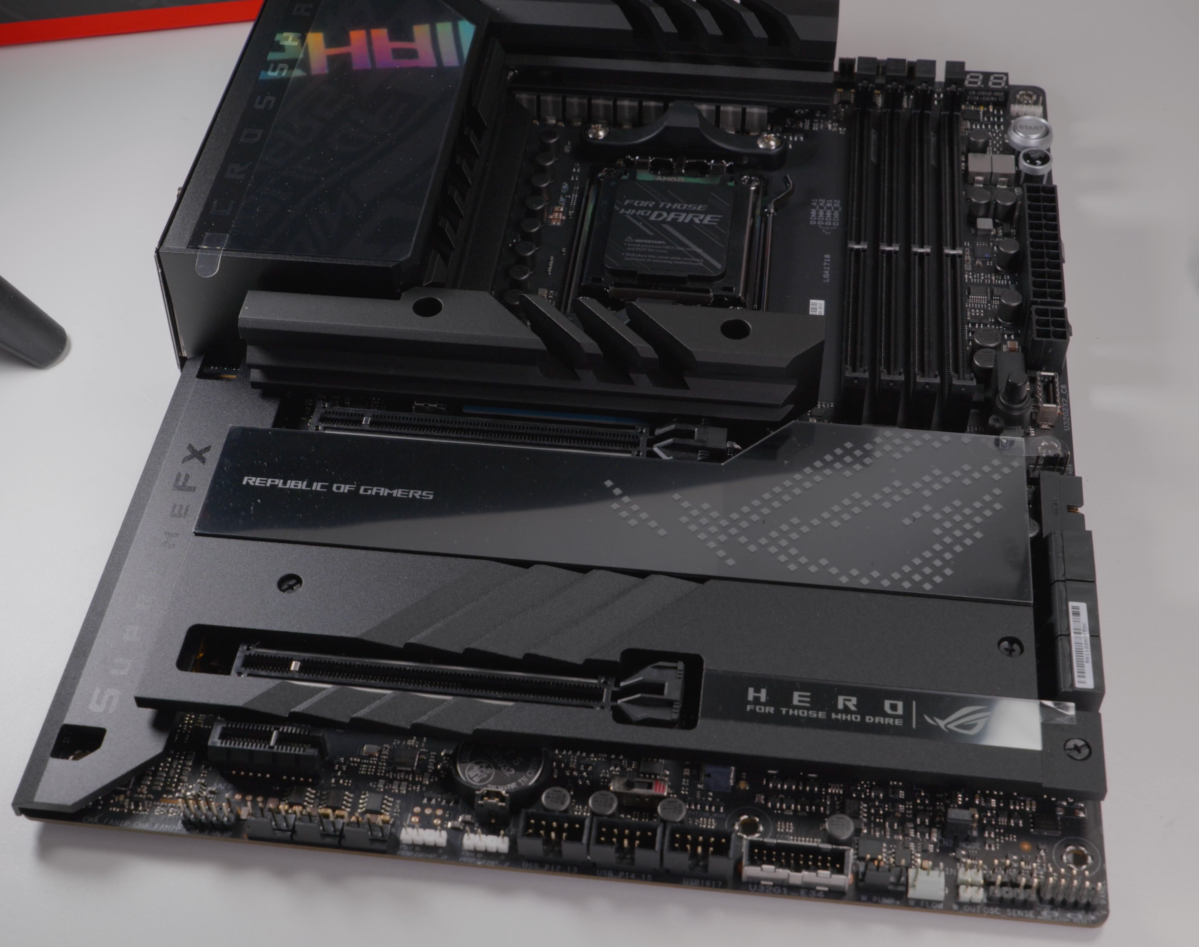
Thiago Trevisan
Yes, this will look sweet in your tempered-glass gaming PC build. What’s more, it will even perform beyond most expectations for workstation users. That’s due to the caliber of included features offered here. Pair it with a Ryzen 9 7900X or 7950X, and you’ll be putting past HEDT CPUs in the rear-view mirror. (Ahem, Intel 10980XE.)
With its premium price, the Hero differentiates itself from the lower-tier motherboards such as the Asus X670E Strix in a few ways that enhance the I/O experience.
USB4? Yep, it’s here and the fastest speeds we’ve seen to date from USB—up to 40Gb/s. Six SATA ports, and a smattering of M.2 NVMe slots make this a content creators dream come true. (PCIe Gen 5 ensures you’ll have plenty of future headroom for upgradability, too.)
Overclocking enthusiasts take note: You’ll have the awesome start button (something that should be included in every motherboard!). Clear CMOS and BIOS Flashback are both available to ensure things can be reset if need be. A neat “Q-Code” display on the top right helps you diagnose issues rapidly. These features come in handy for everyday use as well as troubleshooting, even if you never plan to turn that overclocking dial.
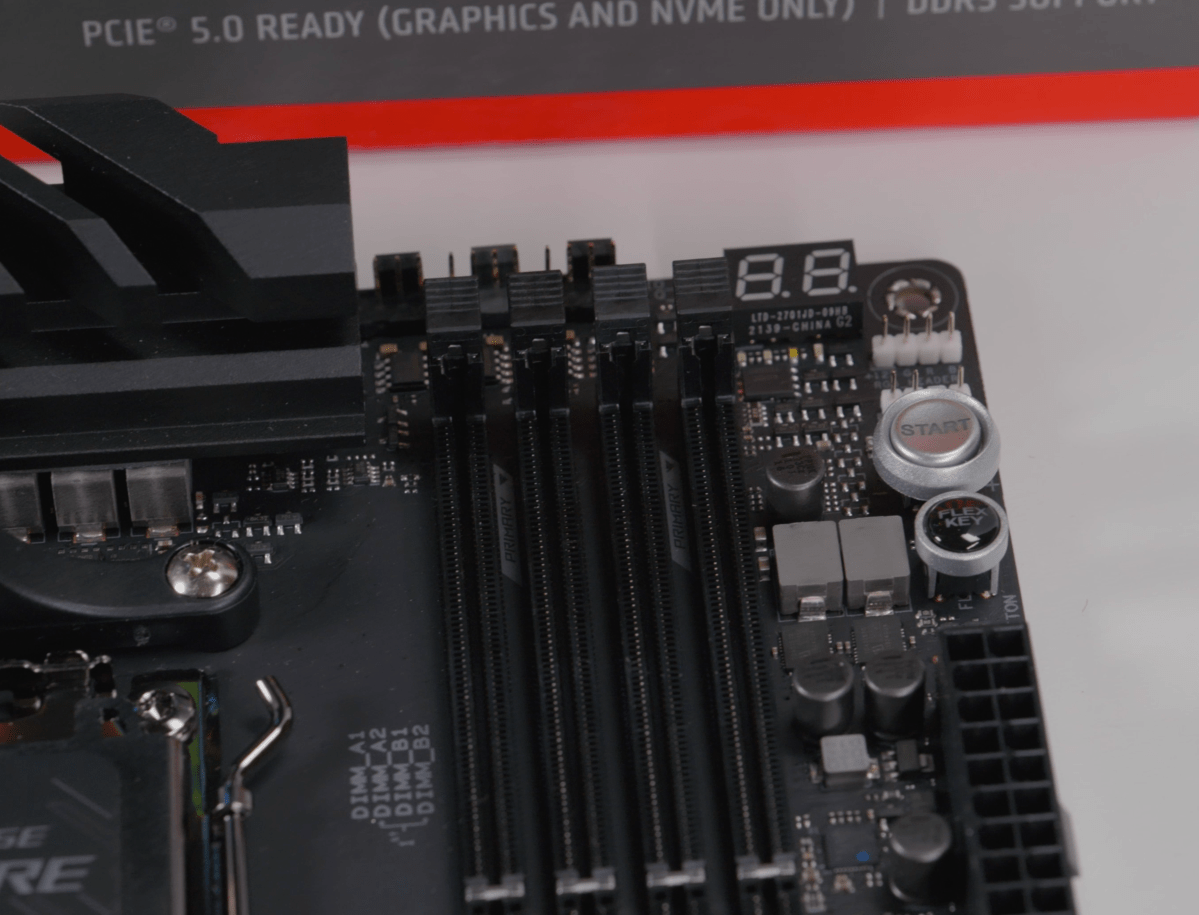
Thiago Trevisan
DDR5 and PCIe Gen 5 are here to speed things up, in both gaming and everyday use. Want to pile on M.2 drives with hyper-fast speeds? This motherboard has the chops to handle that, as well as your PCIe Gen 4 GPU such as the Nvidia RTX 4090. With a healthy dose of PCIe lanes, you’ll be far from saturating them in most use cases.
12 USB ports are nothing to scoff at, and very few motherboards include the super speedy USB 4. Like Thunderbolt, it has a wide-ranging potential for utility alongside its speed – such as displaying out to monitors.
With Ryzen 7000, you’ll even be able to use the integrated iGPU if you need to troubleshoot your build without having to install a discreet GPU—a great quality-of-life feature that can “save the day” when you least expect it!
If you want clear audio, the ROG SupremeFX ALC4082 Codec fits the bill and includes all the input and outputs you’d want.
Networking is standard here, with Intel’s 2.5GbE and 6E Wi-Fi. We’d love to see a 10GbE port offered on this class of motherboard, as many enthusiast users would make use of it among the otherwise stellar I/O lineup.
We now expect these creature comforts everywhere: Q-Release to quickly free the GPU, and Q-Latch to easily install M.2 drives are now de rigueur creature comforts that turn burdensome build tasks into fun-to-use little mechanical innovations!
Asus ROG Crosshair X670E Hero: Design
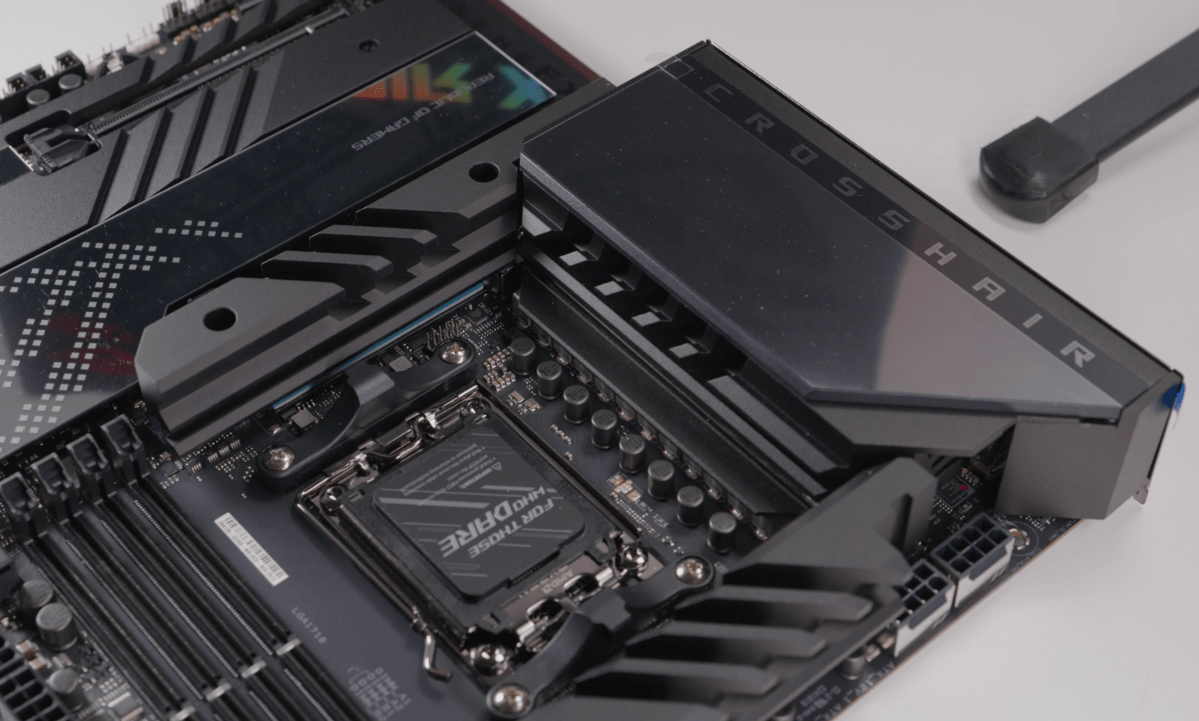
Thiago Trevisan
The $699 MSRP ROG Crosshair X670-E Hero wastes no time letting you know its worth. From the moment you lay eyes on its gorgeous design, you know you’re in the presence of an enthusiast masterpiece!
Starting with the I/O shield area, you’ll get a tasty treat with the “Polymo” customizable RGB effects and subtle Crosshair branding. Next, take in the chiseled VRM and M.2 heatsinks, as well as the beautifully done PCIe slot area in the middle.
Mirror-like surfaces surrounded by harder accented metal heatsink zones combine for a premium look. Sure, your GPU will likely obfuscate most of this area—but it’s still glorious to look at, and inspires real pride of ownership!
The back is more ordinary, with a simple stamping of the motherboard name. We’d love to see a backplate like what the Asus ROG Z790 Hero offers, however.
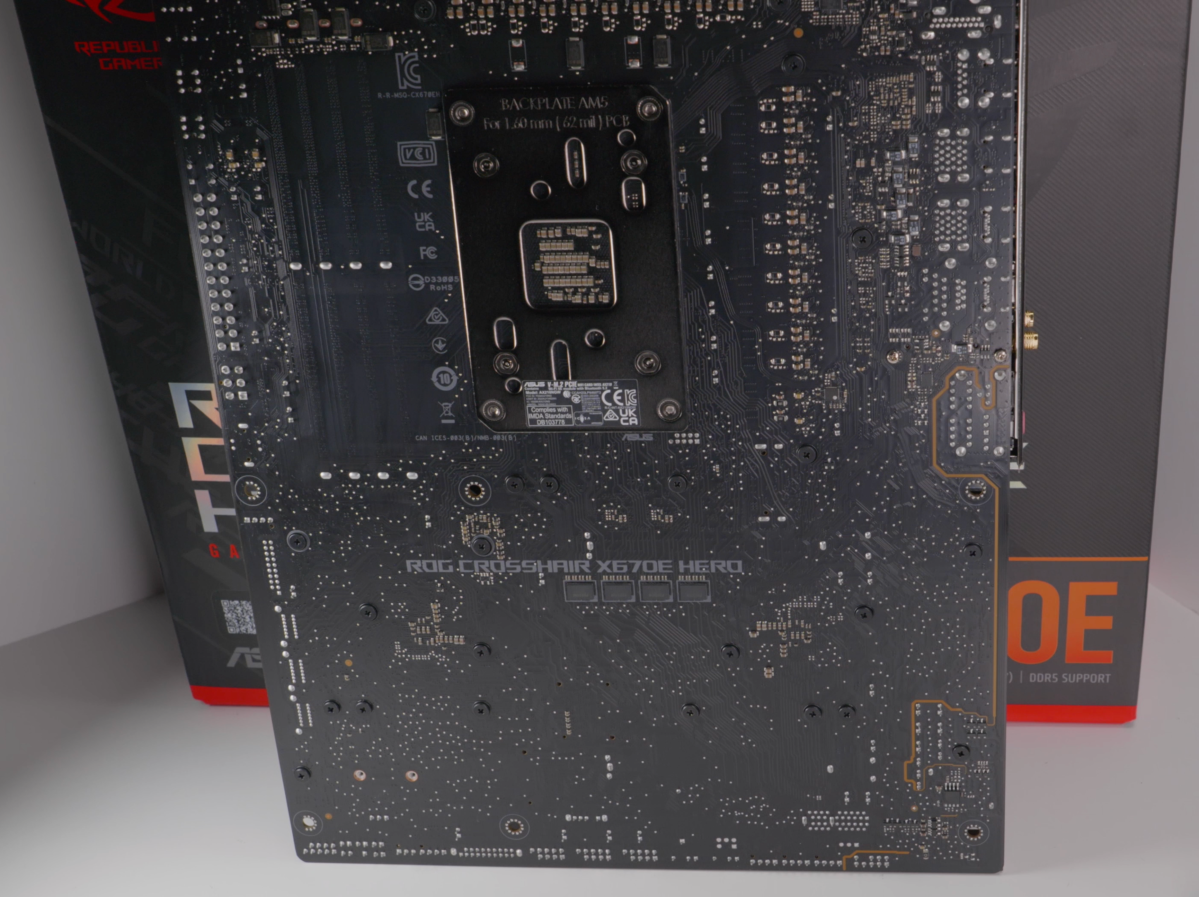
The Asus Crosshair X670E Hero is built from high-quality materials, even the simplistic backside.
Thiago Trevisan
Overall, it’s a very attractive motherboard with a subtle, almost smoked-mirror look to it. Materials used are high quality and feel great.
Asus ROG Crosshair X670E Hero: Performance, software, and BIOS
Packing 18+2 power stages, with what Asus calls “Teamed Power Stage Design,” makes the board sound powerful, right? And it is—it can easily tame the hearty Ryzen 9 7950X without compromise.
Performance is robust, whether you’re talking about gaming or workstation duties. Gamers will rejoice in the fast DDR5 speeds, and with RAM pricing coming down, it makes the prospect more appealing.
You don’t get the option of DDR4 on AM5 motherboards, as you do on Intel’s Z790 lineup, but DDR 5 ensures you’re future-proofed.
The Asus BIOS adds to the pleasure by being as good as ever for tinkerers. Overclocking RAM, undervolting CPUs, it’s all here—and more. It’s easy to use, intuitive, and full of options for the advanced user. If you’d rather sit back and let the motherboard do all the work, it can handle that spectacularly, as well.
Asus Ai overclocking and DDR5 preset RAM profiles keep your hardware working at peak capabilities with a click of a button.
Asus’ Armoury Crate software has also been much improved this generation for those who prefer to stay out of the BIOS altogether. It can do fan profiles with Fan Xpert, Ai overclock your CPU, and even customize your RGB with Aura Sync. It can pull up driver updates for your motherboard, making it a one-stop shop for many users. The interface is attractive and easy to use, which is a plus—since motherboard software has historically been a bit bloated in the past.
Should you buy the Asus ROG Crosshair X670-E Hero?
The Asus ROG Crosshair X670-E Hero brings enthusiast-grade features to satisfy both gamers and content creators. It does so with very few compromises, and while offering tremendous style. It’s a real class act.
Sure, it’d be nice to see 10GbE rounding out the premium features, but it’s still chock full of goodies. It packs all the new-generation buzzwords such as PCIe Gen 5 and DDR5 and offers a healthy dose of PCIE lanes. These all help to justify the $699 MSRP. The fact is, AM5 has higher overall platform costs when DDR5 and Ryzen 7000 CPUs are factored in. But you’re also getting the most features and performance that we’ve seen yet from an AMD mainstream motherboards. (You’d have to step up to the $999 Asus ROG Extreme for features such as 10GbE networking).
If you’re a high-end enthusiast gamer or content creator who strives for one of the best motherboards on the market for AM5, this will be your Hero!
Stay connected with us on social media platform for instant update click here to join our Twitter, & Facebook
We are now on Telegram. Click here to join our channel (@TechiUpdate) and stay updated with the latest Technology headlines.
For all the latest Technology News Click Here
For the latest news and updates, follow us on Google News.
